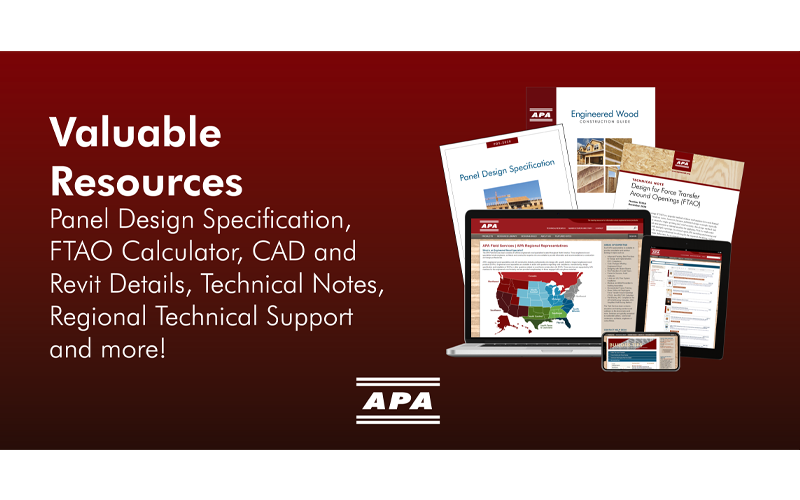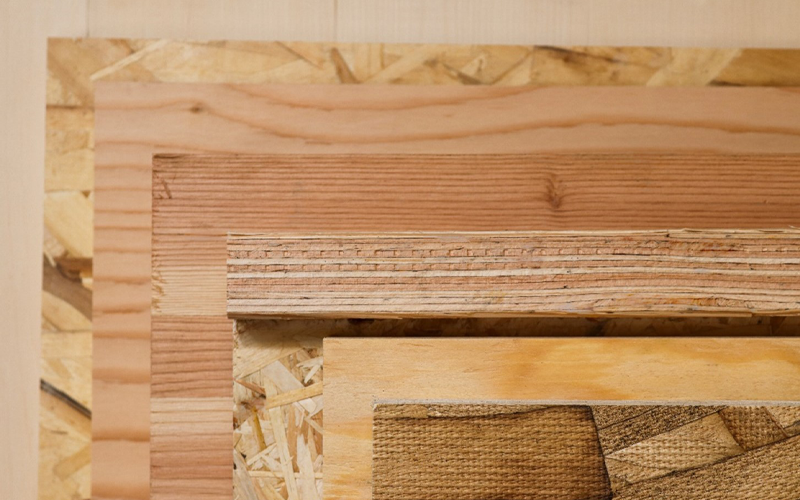Engineered wood’s combination of benefits—from beauty and versatility to sustainability and strength—has made it a popular material for commercial projects such as mixed-use buildings, low-rise office structures and even eight-story mass-timber high rises.
Whether you’re just starting out using engineered wood products (EWP) or have been incorporating EWP into designs for years, APA – The Engineered Wood Association offers an extensive library of resources along with calculators, design downloads and in-person expertise to help you find the best solution to each challenge.
Here is just a small sampling of the free resources and support you can access on www.apawood.org.
1. Sheathing Design with the Panel Design Specification (Form D510)
The Panel Design Specification offers recommended design capacities and design methodds for wood structural panels when used in building construction and related structures. Information in this specification applies to untreated (except as noted) wood structural panels made in accordance with Voluntary Product Standard PS 1 or PS 2, promulgated by the United States Department of Commerce (DOC) and with APA manufacturing standards and specifications.
Among the resources contained within:
- Guidelines for selecting panels, reading the APA panel trademarks and interpreting veneer and panel grades and bond classifications.
- Structural capacities for various commodity panels on the market. Ever wonder what the actual strength difference is between Rated Sheathing and a STRUC I panel? Table 9
provides minimum panel design capacities for different grade and span ratings far beyond the range typically found in other publications. - What sheathing thickness will achieve your span rating? Find the most common performance category and nominal thickness for your required span rating on Table 12.
- Rigidity: How much stiffer is a 1-1/8 Performance Category panel than a 23/32 Performance Category panel? Panel shear rigidity values for calculating your diaphragm deflection found within Form D510 tell the story.
- Design examples to help you apply listed values properly.
2. Force Transfer Around Openings Calculator
The Force Transfer Around Openings (FTAO) method of shear wall analysis offers more versatility than other methods because it allows for the use of narrower wall segments while meeting required height-to-width ratios, and providing a high likelihood that fewer hold-downs will be required.
The FTAO Calculator, a free, Excel-based tool for professional designers, uses FTAO methodology to calculate maximum hold-down force for uplift resistance, the required reinforcing capacity at opening corners, the maximum shear force to determine sheathing attachment and the maximum deflection of the wall system. The calculator includes worksheets for shear walls with one, two and three openings and a design example.
The tool, which is backed by stringent testing, is easy to use and has an accompanying webinar for training.
Access the FTAO Calculator and webinar here.
3. CAD and Revit Details
Tap into APA’s nearly 200 free, downloadable CAD details for wood-frame construction. For building designers and construction pros, these details incorporate recommendations and requirements gleaned from decades of APA research and cover a wide array of construction assemblies. Filter by design topic, including energy-efficient assemblies and wall bracing, or by assembly or related APA publication. CAD details include wall assemblies, beam connections and FTAO details. Each detail is available as a DWG or RVT (2D) file and has an accompanying PDF for easier perusal.
Download construction drawings here.

4. Technical Notes
Dive deeper into critical design details with APA’s range of Technical Notes, which feature detailed color illustrations, examples and tables.
For example, The Effect of Drilled Holes on Glulam (Technical Notes S560 & V700) address issues like running a sprinkler line through a glulam beam or what to do when you get an RFI because the electrician ran the conduit vertically down through a beam. These publications provide helpful examples and recommendations to keep big projects moving forward.
Download Technical Notes S560 & V700 here. Browse all technical notes in the APA Resource Library.
5. Regional Technical Support
Have questions about designing, specifying, installing or inspecting engineered wood products? Set up a complimentary consultation with an APA Engineered Wood Specialist. The APA Field Services team of full-time engineered wood experts come from diverse AEC backgrounds, including engineers, architects and construction experts, and are located throughout North America. With a wealth of both technical and practical knowledge, these experts can provide information and recommendations around code compliance, manufacturing, design, specification and detailing of EWPs, or other questions related to wood-frame construction with EWPs.
Find and contact your local EWP expert here.
No matter the scope of your project, APA is ready to provide support online and in person. Visit www.apawood.org to explore these and additional resources.






